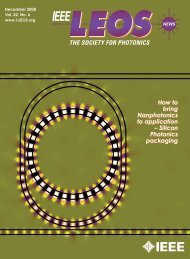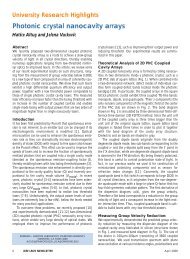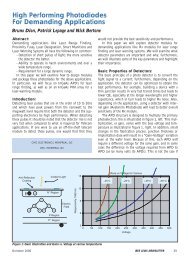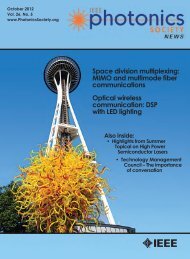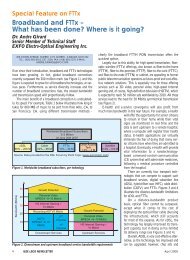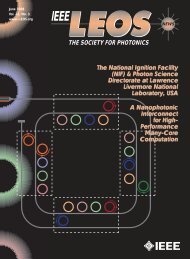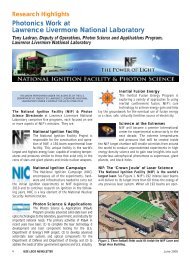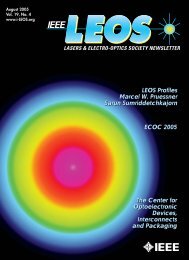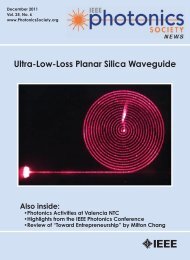20leos05.qxd 10/5/06 2:15 PM Page 23 FWHM, ps 1000 800 600 400 200 40μm 20μm 10μm Excess Bias, % SPAD 3Q T = 175K 4 5 6 7 8 9 10 11 12 13 After Pulsing Probability 1 0.1 200K 190K 0.01 180K 170K 0.001 160K 0.0001 1μ 10μ 100μ 1m 10m 100m 1 Delay, s Figure 4. Device jitter (full-width-at-half-maximum) of SPAD-3Q with device diameters of 10, 20 and 40 μm. Figure 6. Afterpulsing probability versus time after avalanche <strong>for</strong> SPAD-3Q at operating temperatures of 160K, 170K, 180K, 190K and 200K. Noise Equivalent Power, WHz −1/2 10 −12 10 −13 10 −14 10 −15 10 −16 S1 PMT Si SPAD (300K) Hamamatsu R5509a-73 PMT (193K) Ge SPAD (77K) SPAD 3Q (150K, 200K) 10 −17 250 500 750 1000 1250 1500 1750 2000 Wavelength, nm After Pulsing Probability 1 0.1 Full SPAD No InGaAs 0.01 0.001 InP Only T = 200K 0.0001 1μ 10μ 100μ 1m 10m 100m 1 Delay (s) Figure 5. Noise equivalent power spectra of several selected singlephoton detectors with the InGaAs layer removed and the second was with both the InGaAs and InGaAsP layers removed. Whilst these measurements are ongoing at the time of writing, it appears that similar lifetimes and activation energies are observed – leading to the likelihood of the afterpulsing behaviour being dominated by the InP layer. Of particular relevance to the application of quantum key distribution is the count rate limitation imposed by the deleterious effects of afterpulsing in these SPADs – effects which have reduced QKD clock rates to, typically, MHz rates, far less than the potential rates af<strong>for</strong>ded by consideration alone of the subnanosecond jitter in these devices, which, in the absence of afterpulsing, should permit GHz clock rates as previously demonstrated with Si-based SPADs [4][5]. Figure 7. Afterpulsing probability versus time after avalanche at operating temperature of 200K <strong>for</strong> (1) SPAD-3Q; (2) similar structure without InGaAs layer; (3) similar design without InGaAs and InGaAsP IV. Infrared Single- Photon <strong>Detectors</strong> in <strong>Quantum</strong> Key Distribution The application of quantum key distribution places particular requirements on the per<strong>for</strong>mance of infrared photoncounting detectors. In quantum key distribution systems, a figure of merit used is the quantum bit error rate (QBER), which can be simply described [12] as: QBER = N WRONG N WRONG + N RIGHT where N WRONG is the rate of spurious counts and N RIGHT is the rate of correct counts in the time slot of expected photon arrival. The spurious counts can result from a number of factors external to the detector, <strong>for</strong> exam- October 2006 IEEE LEOS NEWSLETTER 23
20leos05.qxd 10/5/06 2:15 PM Page 24 ple light leakage into the system, or non-ideal passive optical components in the transmission channel. However spurious counts can also be generated by detector dark counts, including dark counts caused by afterpulsing. Also, the rate of correct counts is likely to depend linearly on the detector single-photon detection efficiency. For improved QKD system per<strong>for</strong>mance in terms of reduced quantum bit error rate, the single-photon detection efficiency should be maximized and the dark count rate minimized to reduce the probability of spurious counts within a photon arrival time window, which is usually set by the detector gate width. However, in addition, the detector jitter should be kept well below the gate width. Generally there is a trade-off between reducing the timing window which will improve the QBER by decreasing the probability of a random dark event occurring within that period, and reducing the gate width such that detector jitter and electrical gate rise-times will reduce the effective detection efficiency, thus increasing the QBER. Furthermore, the use of, <strong>for</strong> example, the “one-time pad approach” to data encryption places particular emphasis on encryption key length and, as a consequence of this, on the key distribution rate. Currently, the limitation on the key distribution rate in QKD systems utilizing InGaAs/InP SPADs is the effect of the afterpulsing phenomenon. It is clear that much research remains to be per<strong>for</strong>med to enable the materials improvement necessary to reduce this issue to a significantly more manageable level. Whilst Si SPADs remain the outstanding detector of choice <strong>for</strong> QKD applications at wavelengths less than 1000nm, some work has been per<strong>for</strong>med on longer-wavelength Ge-containing Si structures [13] <strong>for</strong> SPADs, although it remains unclear whether they will prove more suitable than InGaAs/InP single-photon detectors at the strategically important 1550nm wavelength band. References [1] G.S. Buller, S.J. Fancey, J.S. Massa, A.C. Walker, S. Cova, and A. Lacaita. “Time-resolved photoluminescence measurements of InGaAs/InP multiple-quantum-well structures at 1.3 µm wavelengths by use of germanium single-photon avalanche photodiodes” Appl. Opt., vol. 35, pp 916-921, 1996 [2] A.L. Lacaita, P.A. Francese and S. Cova.. “Single-photon optical-time-domain reflectometer at 1.3 µm with 5 cm resolution and high sensitivity” Opt. Lett., vol. 18, pp 1110-1112, 1993 [3] G.S. Buller, R. D. Harkins, A. McCarthy, P.A. Hiskett, G.R. MacKinnon, G.R. Smith, R. Sung, A.M. Wallace, R.A. Lamb “A multiple wavelength time-offlight sensor based on time-correlated single-photon counting” Rev. Sci. Instrum., vol. 76, article no. 083112, 2005 [4] K.J. Gordon, V. Fernandez, P.D. Townsend, and G.S. Buller, “A short wavelength gigahertz clocked fiberoptic quantum key distribution system”, IEEE J. Quant. Electron., vol. 40, pp 900-908, 2004 [5] K.J. Gordon, V Fernandez, G.S. Buller, I. Rech, S.D. Cova, and P.D. Townsend , “<strong>Quantum</strong> key distribution clocked at 2GHz”, Optics Express, vol. 13, pp 3015- 3020, 2005 [6] F. Stellari, A. Tosi, F. Zappa and S. Cova, “CMOS circuit testing via time-resolved luminescence measurements and simulations”, IEEE Trans. Instrumentation and Measurement, vol. 51,, pp 163-169 (2004) [7] A. Lacaita, F. Zappa, S. Cova, P. Lovati, “Single-photon detection beyond 1µm: per<strong>for</strong>mance of commercially available InGaAs/InP detectors”, Appl. Opt., vol. 35, pp 2986-2996, 1996 [8] P.A. Hiskett, G.S. Buller, A.Y. Loudon, J.M. Smith, I. Gontijo, A.C. Walker, P.D. Townsend, M.J. Robertson, “Per<strong>for</strong>mance and design of InGaAs InP photodiodes <strong>for</strong> single-photon counting at 1.55 µm”, Appl. Opt., vol. 39, pp 6818-6829, 2000 [9] J.C. Campbell, A.G. Dentai, W.S. Holden, B.L. Kasper, “High per<strong>for</strong>mance avalanche photodiode with separate absorption grading and multiplication regions”, Electron. Lett., vol. 20, pp 596-598, 1984 [10]Y. Liu, S. R. Forrest, M.J. Lange, G.H. Olsen, and D.E. Ackley, “A planar InP/InGaAs avalanche photodiode with floating guard ring and double diffused junction”, J. Lightwave Technol., vol. 10, pp 182- 193, 1992 [11]S. Pellegrini, R.E. Warburton, L.J.J. Tan, J.S. Ng, A. Krysa, K. Groom, J.P.R. David, S. Cova, M.J. Robertson and G.S. Buller, “Design and per<strong>for</strong>mance of an InGaAs/InP single-photon avalanche diode detector” IEEE J. Quant. Electron., vol. 42, pp 397- 417, 2006 [12]P.D. Townsend, “<strong>Quantum</strong> cryptography on optical fiber networks”, Optical Fiber Technology, vol. 4, pp345-370, 1998 [13]A.Y. Loudon, P.A. Hiskett, G.S. Buller, R.T. Carline, D.C. Herbert, W.Y. Leong, J.G. Rarity, “Enhancement of the infrared detection efficiency in Si photon counting avalanche photodiode using SiGe absorbing layers”, Opt. Lett., vol. 27, pp 219-221, 2002 24 IEEE LEOS NEWSLETTER October 2006



